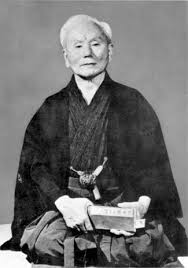Shotokan History

Karate means “empty hand”, and Karate-do translates to “the way of Karate”. Shotokan Karate is a weaponless martial art that is founded on the basic techniques of punching, striking, kicking and blocking, yet there is a deeper aspect to serious Karate training which deals with character development. Shotokan Karate is a way for an individual to realize greater potential and expand the limits of that individual’s physical and mental capabilities. Karate in an excellent, time-proven method of personal development. Shotokan Karate is a traditional Japanese Martial Art founded by Master Gichin Funakoshi. Shotokan Karate remains firmly rooted in a strong martial arts tradition, emphasizing lifetime training for a healthy mind and body, rather than strictly as a sport.
From Wikipedia, the free encyclopedia
Shotokan (松濤館 Shōtōkan?) is a style of karate, developed from various martial arts by Gichin Funakoshi (1868–1957) and his son Gigo (Yoshitaka) Funakoshi (1906–1945). Gichin was born inOkinawa and is widely credited with popularizing “karate do” through a series of public demonstrations, and by promoting the development of university karate clubs, including those atKeio, Waseda, Hitotsubashi (Shodai), Takushoku, Chuo, Gakushuin, and Hosei.
Funakoshi had many students at the university clubs and outside dojos, who continued to teach karate after his death in 1957. However, internal disagreements (in particular the notion that competition is contrary to the essence of karate) led to the creation of different organizations—including an initial split between the Japan Karate Association (headed by Masatoshi Nakayama) and the Shotokai (headed by Motonobu Hironishi and Shigeru Egami), followed by many others—so that today there is no single “Shotokan school”, although they all bear Funakoshi’s influence.
As the most widely practiced style, Shotokan is considered a traditional and influential form of karate do.